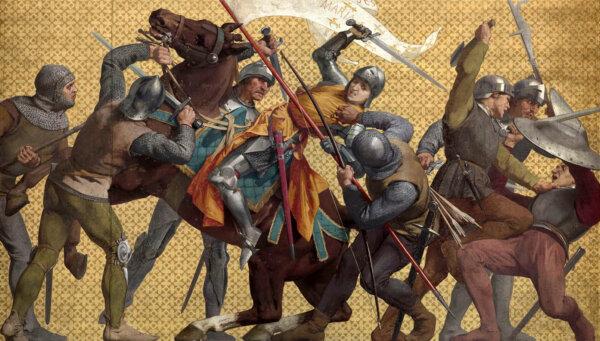Commentary
In 1425, a French peasant girl in her early teens began having a series of visions. She claimed to have seen strange lights and the figures of St. Michael the Archangel, St. Catherine, and St. Margaret. In time, these visions began to tell Joan that she would play a role in freeing France from its enemies.
By the period of Joan’s visions, France and England had been at war for almost a century and during that time the French people had suffered greatly from the depredations of rival armies criss-crossing the country, burning, looting, killing, and kidnapping. Most of the country, including Paris the capital, was occupied by the soldiers of the English king or the rebellious Duke of Burgundy.
The claimant to the French throne, Charles the Dauphin, could not be crowned because the traditional site of coronations, the town of Reims, was under enemy control. Moreover, Charles was neither a competent nor enthusiastic warrior for his own cause, preferring to loll about in safety at his court in Chinon, surrounded by some very unsavoury advisers.
It was to Chinon and the Dauphin that Joan’s visions directed her, but it took her some time before she could find anyone who could safely take her there or arrange a meeting with Charles. Finally in 1428, she convinced the local garrison commander to lend her some soldiers to escort her to Chinon and to write a letter of reference. Dressed in men’s clothing, she arrived at the court.
A very skeptical Charles had been warned about this bizarre visitor bearing a message from the angels and hid himself in the reception room while one of his courtiers sat on the throne imitating him. Joan immediately saw the ruse, and taking the prince aside confided to him a secret about Charles she had been vouchsafed by her visions. This seems to have convinced him of Joan’s heaven-sent bonafides. He ordered her a set of armour and entrusted her with an army which she was to lead to break the English siege of the city of Orléans.
Joan sent a bold letter to the English, declaring that she had been sent by God to drive them from France and to ensure the triumph of the Dauphin. Inspired by this astonishing girl, the French troops were victorious at Orléans, causing many Frenchmen to believe that she was a divine deliverer and the English to believe that she was a witch and a servant of the devil. Joan directed her forces to further battles to clear the way to Reims and on July 17, 1429, the Dauphin was crowned as Charles VII. At his side was Joan, carrying her banner adorned with the saints who had appeared in her visions.

From this point, Joan’s story turns darker. Advisers to Charles urged negotiations with the Burgundians, especially after an attack on Paris led by Joan had failed, to the detriment of her reputation. A truce was agreed to, which lasted until the spring of 1430, and when fighting resumed, Joan participated in a skirmish at Compiègne where she was captured by troops loyal to the Duke of Burgundy. Charles VII made no attempt to rescue or ransom Joan from the Burgundians, who happily sold her to the English who put her in the hands of Bishop Pierre Cauchon.
Cauchon moved Joan to Rouen in Normandy where she was put on trial in a church court for heresy. It was important for the English cause that she not be treated merely as a military prisoner but as a follower of demons. To discredit Joan was to discredit Charles VII whom she had placed on the throne, so there was never any chance that she would receive a fair hearing. Her cross-dressing (wearing men’s clothing while in battle), her visions, and her claims to be inspired directly by God were all held against her and she was found guilty.
Threatened with immediate execution, she agreed to sign a document in which she renounced her visions and agreed to never wear men’s clothing again. Within days, however, she was discovered in men’s dress (probably because she was provided with no alternatives) and declared a relapsed heretic who could be forthwith executed. On May 30, 1431, Joan of Arc was burned at the stake. She was 19 years old.
Joan had prophesied that the English would soon lose their French holdings and, indeed, by 1453 they had been driven out of France. By that time, the French church had reconsidered its verdict and declared that Joan’s trial was invalid.
Joan of Arc was canonized in 1920. She is the patron saint of France, women, prisoners, rape victims, people mocked for their piety, and soldiers.
Views expressed in this article are opinions of the author and do not necessarily reflect the views of The Epoch Times.
Please rewrite this sentence.
Source link







